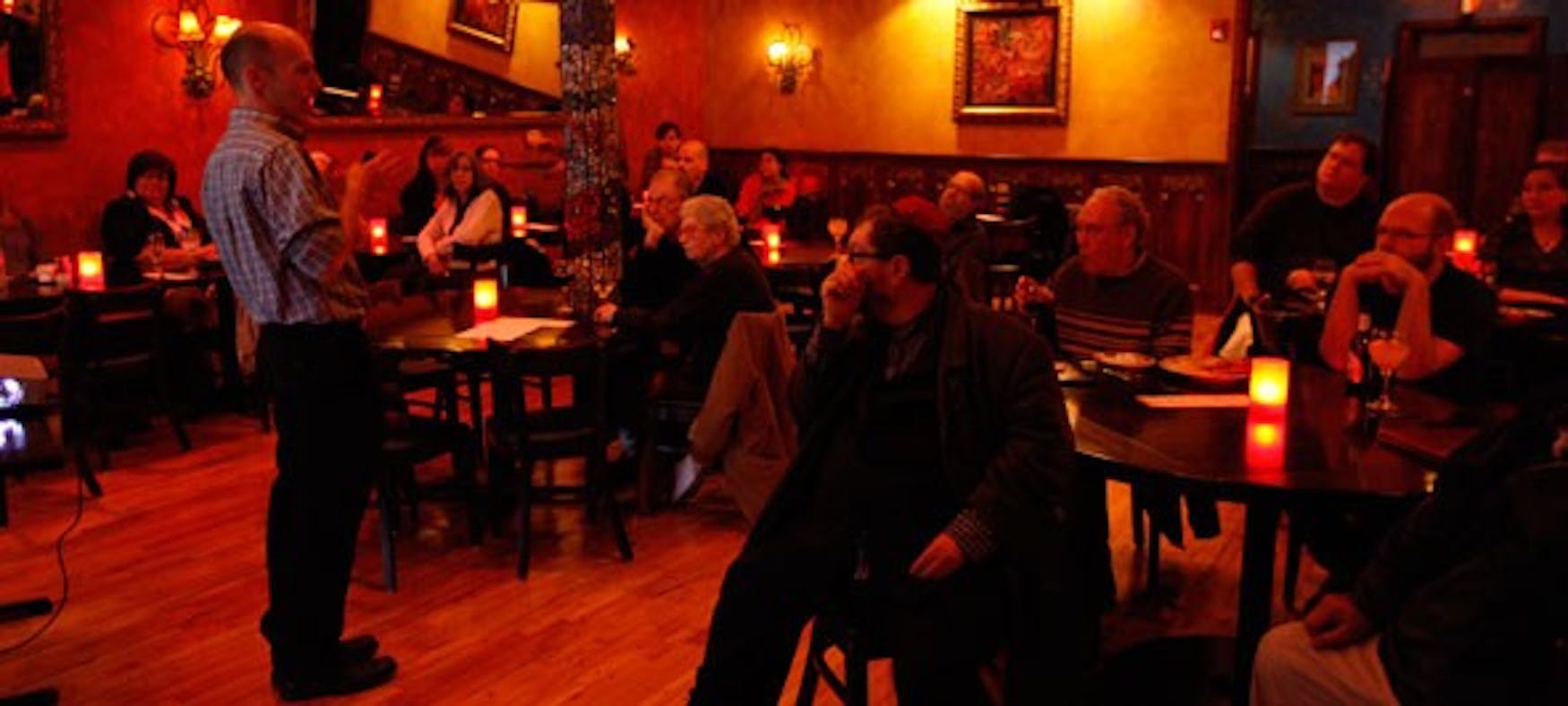Super Fly
Fruit flies and human sleep converge at this month's Cafe Science event
Last Monday in the dimly lit dining room tucked in the back of Solea Restaurant & Tapas Bar, Prof. Leslie Griffith (BIOL) stood in front of a dozen or so guests and lectured about fruit flies and human sleep.
At this month’s Cafe Science, Griffith—the evening’s guest speaker—spoke about her research in a segment called “Sleep: Why You Should, Why You Can’t, and What Do Fruit Flies Have to Do With It.”
Cafe Science is an hour-long discussion that features a different Brandeis science professor each session, with topics ranging from genetics to physics. The event takes place at Solea on the first Monday of every month. Admission is open to the Brandeis community as well as the public and costs $10, with a complimentary drink included.
Throughout the evening, some guests ordered tapas, while others simply sipped their complimentary drinks, listening intently as Griffith spoke. One of the guests, Ann Nguyen, is a former Waltham resident who regularly attends public science events. “I’ve been to a number of Brandeis Cafe Science events in the past couple of years, and they’re always very good with very diverse topics,” she said.
Griffith began her lecture by outlining the basics of sleep. “Humans spend one third of their lives sleeping,” Griffith said, explaining that our daily need for sleep is tethered to the earth’s rotational patterns. The circadian rhythm, a process by which the body’s functions react to the Earth’s 24-hour clock, uses factors such as light to cue the brain that it’s time to sleep.
“We are all entrained by signals to have much of our metabolism and our behavior entrained to the 24-hour rotation of the earth,” Griffith said.
According to Griffith, a lack of sleep can lead to a predisposition to depression, weakened immune response, obesity and heart disease. Insufficient sleep affects a sizeable portion of the American public. “Recent studies have shown that 20 to 30 percent of Americans are getting less than six hours of sleep per night,” Griffith said.
To further our understanding of human sleeping patterns, Griffith said, observing the sleeping patterns of other animals can be beneficial.
Aside from basic observation and techniques that measure the changes in brain activity between the awake and asleep states, the tools for studying human sleep are limited.
There are a number of known sleeping disorders like insomnia, sleep apnea and sleep paralysis, but there are hardly enough drugs for treatment.
“It’s really hard to stick electrodes and drugs into somebody’s brain. We need other animal models,” Griffith explained.
All animals sleep, some much more than others, some during the day and others at night. At her research lab at Brandeis, Griffith and a research team of post doctorate students and graduate students study the behavioral patterns of fruit flies. She found that fruit flies would be an ideal animal to study. “Flies sleep a lot like we do,” Griffith said.
Like humans, fruit flies are diurnal animals, meaning that they are active during the day and use the night to recharge.
Fruit flies are ideal animals for studying sleep because of their small brains and relatively few neurons, which make them easy to observe and manipulate in the lab, Griffith explained.
“The most important thing is that they’re very genetically malleable,” Griffith said.
Before she could start comparing the way fruit flies sleep to the way human beings do, Griffith first had to answer an important question: “Do flies fall asleep like humans do?” The answer was yes.
Both humans and fruit flies fall asleep according to a kind of switch in their brains. According to Griffith, a neuron called Gamma-aminobutyric Acid (GABA) is the key. “GABA is an inhibiting neurotransmitter in the brain,” she said “It controls many important sleep circuits in the brain.”
In an alert human brain, GABA neurons are inhibited, stimulating the handful of sensory related neurons in the brain. When a person is asleep, however, GABA neurons dominate and inhibit the brain’s sensory neurons.
Griffith hypothesized that this system was similar in fruit flies, and so she and her research team began to experiment with the GABA neurons in fruit flies in order to test their prediction.
The research, spearheaded by Griffith’s post-doctorate lab assistant Katherine Parisky, confirmed this hypothesis. “You could down -regulate the GABA neurons or overexpress the GABA neurons,” Griffith said “If GABA is required for sleep, down-regulating would decrease sleep and overexpressing them would increase sleep.”
While Griffith’s research has yet to result in a quick fix for a restless brain, she continues to seek insight by observing fruit flies. “The story is ongoing,” she said. With the world as connected as it is, it’s no coincidence that people are increasingly restless at night. “We live in a 24/7 world. Somewhere in the world, at any time of day, someone is doing something, and you can see it on TV or on your phone. People tend to sleep less,” Griffith said.



Please note All comments are eligible for publication in The Justice.